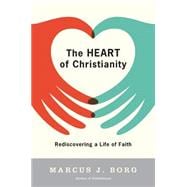About This Book
The Heart of Christianity: Rediscovering a Life of Faith
ISBN: 9780060730680
About the Book
"The Heart of Christianity: Rediscovering a Life of Faith" by Marcus J. Borg is a thought-provoking book that delves into the core principles of Christian faith. Written in an engaging and accessible style, this book challenges readers to rethink their understanding of Christianity and its relevance in today's world. Borg, a renowned Jesus scholar, argues that the essential elements of a Christian life—faith, being born again, the kingdom of God, and the gospel of love—are just as vital now as they have always been.
Who Uses It?
Primarily, this book is used by students and educators in theology and religious studies courses at the college and university levels. It is also a valuable resource for anyone interested in exploring the transformative power of Christianity, including those disillusioned with traditional church teachings and seeking a more inclusive and justice-oriented faith.
History and Editions
First published in 2004, "The Heart of Christianity" has been widely read and discussed. The book has undergone several reprints, with the most recent edition being published in 2015. This edition retains Borg's original insights while addressing contemporary issues within the Christian community.
Author and Other Works
Marcus J. Borg is a prominent author in the field of Christian studies. His other notable works include "Meeting Jesus Again for the First Time" and "Jesus: A Revolutionary Biography." Borg is known for his ability to make complex theological concepts accessible and engaging for a broad audience.
Key Features
- Reconceptualizing Faith: Borg offers a fresh perspective on traditional Christian beliefs, emphasizing personal transformation and community justice.
- Engaging Storytelling: The book uses storytelling to communicate theological ideas, making it an enjoyable read for both scholars and laypeople.
- Inclusive Spirituality: Borg explores how faith can be practiced within various cultural contexts, highlighting the universal values of love and justice.
Detailed Information
ISBNs and Formats
Hardcover: ISBN-13: 9780060730680
eTextbook: ISBN-13: 9780061746598 (The ebook for "The Heart of Christianity: Rediscovering a Life of Faith" is available right here on eCampus.com!)
eTextbook: ISBN-13: 9780061746604 (The ebook for "The Heart of Christianity: Rediscovering a Life of Faith" is available right here on eCampus.com!)
Loose-leaf: Not available
Rental Options: Available through eCampus.com with various rental durations
Publication Details
Publisher: HarperCollins
Publication Date: July 21, 2015
Number of Pages: 256
Language: English
Item Weight: Not specified
Dimensions: 5.31 x 8.00 x 0.58 inches
Other Editions and Formats
First Edition (2004): Available through eCampus.com
Related ISBNs:
9780061746598
9780061746604
Rental Options are available through eCampus.com with various rental durations.









